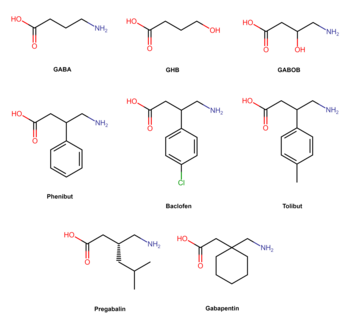Phenibut
Phenibut, sold under the brand name Anvifen among others,[1] is a central nervous system (CNS) depressant with anxiolytic effects, and is used to treat anxiety, insomnia, and for a variety of other indications.
[6][5] Side effects of phenibut can include sedation, sleepiness, nausea, irritability, agitation, dizziness, euphoria, and sometimes headache, among others.
[12] Phenibut is used in Russia, Ukraine, Belarus and Latvia as a pharmaceutical drug to treat anxiety and to improve sleep (e.g., in the treatment of insomnia).
[5][6] It is also used for various other indications, including the treatment of asthenia, depression, alcoholism, alcohol withdrawal syndrome, post-traumatic stress disorder, stuttering, tics, vestibular disorders, Ménière's disease, dizziness, for the prevention of motion sickness, and for the prevention of anxiety before or after surgical procedures or painful diagnostic tests.
[5][7] Possible side effects may include sedation, somnolence, nausea, irritability, agitation, anxiety, dizziness, headache, and allergic reactions such as skin rash and itching.
[3] Due to its CNS depressant effects, people taking phenibut should refrain from potentially dangerous activities such as operating heavy machinery.
[6][7] In overdose, phenibut can cause severe drowsiness, nausea, vomiting, eosinophilia, lowered blood pressure, renal impairment, and, above 7 grams, fatty liver degeneration.
[7] Lethargy, somnolence, agitation, delirium, tonic–clonic seizures, reduced consciousness or unconsciousness, and unresponsiveness have been reported in recreational users who have overdosed.
[5][needs update] Withdrawal symptoms may occur upon discontinuation, and, in recreational users taking high doses, have been reported to include severe rebound anxiety, insomnia, anger, irritability, agitation, visual and auditory hallucinations, and acute psychosis.
[15] Phenibut may mutually potentiate and extend the duration of the effects of other CNS depressants, including anxiolytics, antipsychotics, sedatives, opioids, anticonvulsants, and alcohol.
Three papers published in Russian by Soviet scientists in 1979, 1986, and 1990 report that phenibut increases dopamine in the striatum of rats and in the mouse brain.
[6] Approximately 0.1% of an administered dose of phenibut reportedly penetrates into the brain, with this said to occur to a much greater extent in young people and the elderly.
[6] Following a single 250 mg dose in healthy volunteers, its elimination half-life was approximately 5.3 hours and the drug was largely (63%) excreted in the urine unchanged.
[2][6] Phenibut is marketed in Russia, Ukraine, Belarus, and Latvia under the brand names Anvifen, Fenibut, Bifren, and Noofen (Russian: Анвифен, Фенибут, Бифрен and Ноофен, respectively).
[3] Phenibut is used recreationally due to its ability to produce euphoria, anxiolysis, and increased sociability,[3] as well as remaining undetected in routine urinalysis.
[3] In February 2018, the Australian Therapeutic Goods Administration declared it a prohibited (schedule 9) substance, citing health concerns due to withdrawal and overdose.
[28] As of 18 September 2020, France added phenibut to the controlled psychoactive substances list, prohibiting production, sale, storage, and use.

